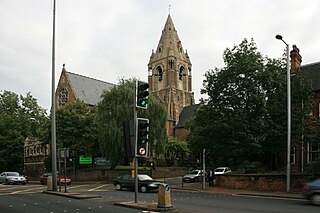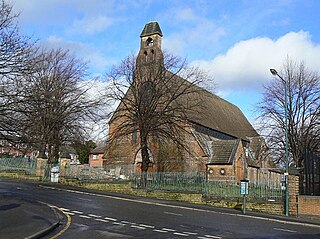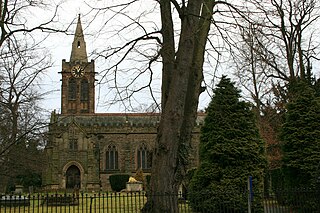
All Saints' Church, Nottingham, is an Anglican church in Nottingham, England.

St. Andrew's Church, Nottingham in Nottinghamshire, England is a parish church in the Church of England.

St Stephen's Church, Sneinton is a parish church in the Church of England. It is the parish church of the Sneinton suburb of Nottingham, Nottinghamshire, England.

St George in the Meadows is a parish church in the Church of England in The Meadows, Nottingham, England.

St Cyprian's Church is a parish church of the Church of England in Nottingham. The church's historic title of St Cyprian of Carthage, Sneinton, is no longer geographically accurate, the boundaries of Sneinton having evolved in the second half of the twentieth century. The church now serves much of Carlton Hill and Bakersfield areas, with only one very small part of the parish being in Sneinton.

St. Albans Church, Forest Town is a parish church in the Church of England in Forest Town, Nottinghamshire.

St Peter's Church, Radford is an Anglican parish church in Radford, Nottingham, located at 171 Hartley Road. It is a Grade II listed building as being of special architectural or historic interest.

Charles Lloyd was a pipe organ builder based in Nottingham who flourished between 1859 and 1908.
St. Paul's Church, George Street, was a Church of England church built as a chapel of ease to St. Mary's Church, Nottingham. It was opened in 1822 and closed in 1924.
St. James' Church, Standard Hill was a Church of England church in Nottingham.

St Matthias' Church, Nottingham, was a Church of England church in Sneinton, Nottingham, between 1868 and 2003. In 2009 the building was reopened as St. Mary & St. George's Coptic Orthodox Church.
St Mark's Church, Nottingham, was a Church of England church in Nottingham, Nottinghamshire, England between 1856 and 1958. The section of Huntingdon Street where the church was located was formerly called Windsor Street.
Emmanuel Church, Nottingham was a Church of England church in Nottingham on Woodborough Road between 1883 and 1972.
St. Philip's Church, Nottingham, was a Church of England church in Nottingham on Pennyfoot Street between 1879 and 1963.

St Christopher's Church, Sneinton is a Church of England church in Sneinton Nottingham.

St. Peter's Church is a Church of England church in Ruddington, Nottinghamshire.

St Andrew's with Castle Gate United Reformed Church is in Nottingham.
William Herbert Higginbottom JP was an architect based in Nottingham.

St Alban the Martyr, Birmingham is a Grade II* listed Church of England parish church in the Anglican Diocese of Birmingham. It is dedicated to Saint Alban, the first British Christian martyr.

William Beedham Starr JP was an architect based in Nottingham.














